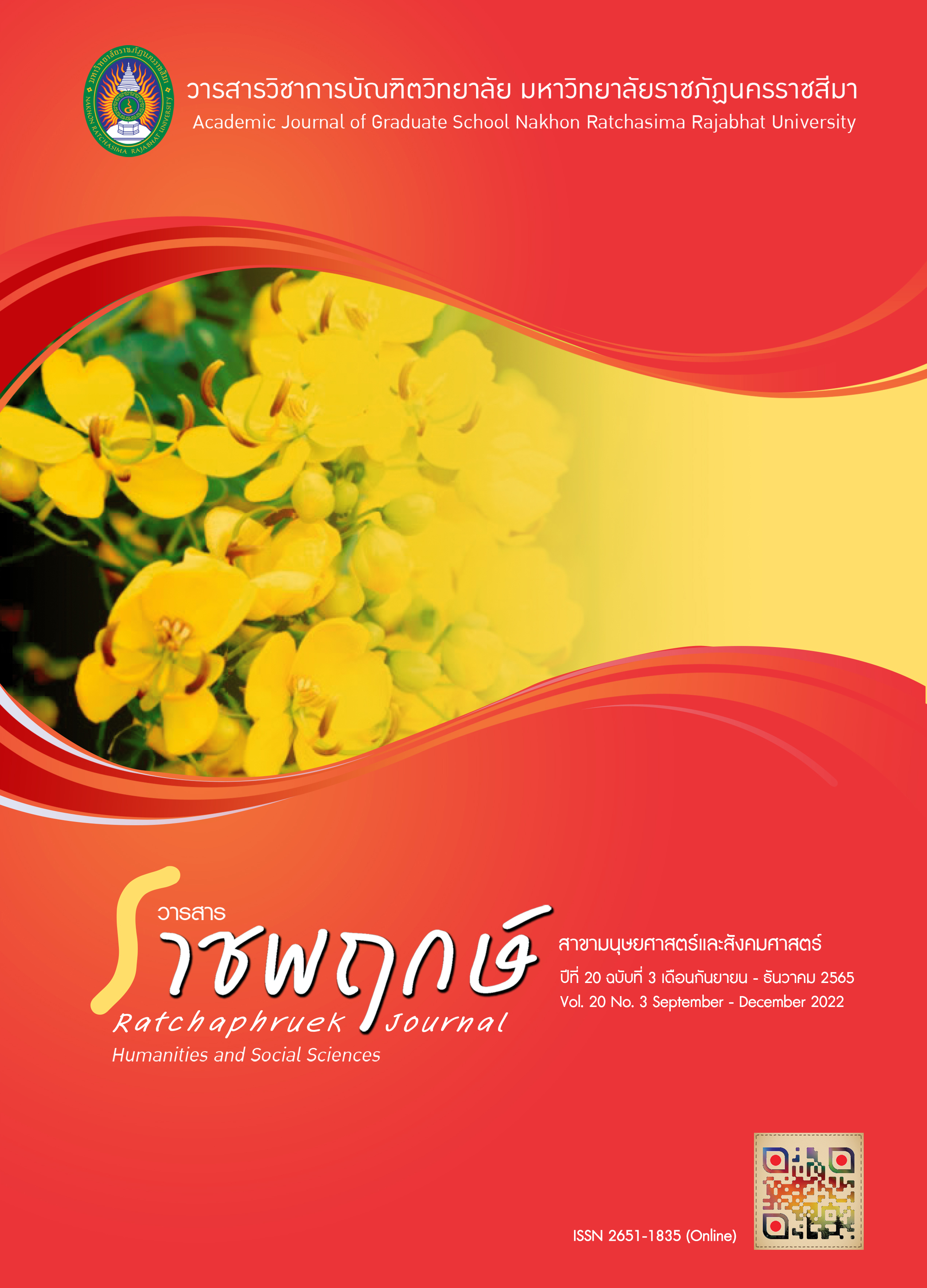การพัฒนาความสามารถในการสื่อสารวิทยาศาสตร์ของนักเรียนชั้นมัธยมศึกษาปีที่ 5 ในหน่วยการเรียนรู้เรื่อง การลำเลียงของพืช โดยใช้การจัดการเรียนรู้แบบสืบเสาะหาความรู้ที่ใช้แบบจำลองเป็นฐาน
Main Article Content
บทคัดย่อ
งานวิจัยนี้เป็นงานวิจัยเชิงปฏิบัติการในชั้นเรียนโดยมีวัตถุประสงค์เพื่อพัฒนาความสามารถในการสื่อสารวิทยาศาสตร์ของนักเรียนชั้นมัธยมศึกษาปีที่ 5 หน่วยการเรียนรู้เรื่อง การลำเลียงของพืช โดยใช้การจัดการเรียนรู้แบบสืบเสาะหาความรู้ที่ใช้แบบจำลองเป็นฐาน กลุ่มตัวอย่างเป็นนักเรียนแผนการเรียนวิทยาศาสตร์-คณิตศาสตร์ จำนวน 34 คน ที่ได้รับการเลือกแบบเจาะจง เครื่องมือที่ใช้ในการวิจัยประกอบด้วย แผนการจัดการเรียนรู้ และแบบประเมินความสามารถในการสื่อสารวิทยาศาสตร์ วิเคราะห์ข้อมูลโดยการหาค่าความถี่ และร้อยละของพัฒนาการ ผลการวิจัย พบว่า การจัดการเรียนรู้แบบสืบเสาะหาความรู้ที่ใช้แบบจำลองเป็นฐาน สามารถพัฒนาความสามารถในการสื่อสารวิทยาศาสตร์ของนักเรียนได้ โดยนักเรียนส่วนใหญ่ คิดเป็นร้อยละ 52.94 (18 คน) มีพัฒนาการการสื่อสารวิทยาศาสตร์ด้านการพูดอยู่ในระดับสูง และนักเรียนส่วนใหญ่ คิดเป็นร้อยละ 38.24 (13 คน) มีพัฒนาการความสามารถในการสื่อสารวิทยาศาสตร์ด้านการเขียนในระดับปานกลาง
Article Details

อนุญาตภายใต้เงื่อนไข Creative Commons Attribution-NonCommercial-NoDerivatives 4.0 International License.
เอกสารอ้างอิง
กมลชนก ชีวะกุล. (2562). การพัฒนาทักษะการสื่อสารวิทยาศาสตร์ของนักเรียนชั้นมัธยมศึกษาปีที่ 5 ด้วยการจัดการเรียนรู้โดยใช้ประเด็นทางสังคมที่เกี่ยวเนื่องกับวิทยาศาสตร์ร่วมกับเครื่องมือไอซีที (วิทยานิพนธ์มหาบัณฑิต, มหาวิทยาลัยเกษตรศาสตร์).
ชาตรี ฝ่ายคำตา และภรทิพย์ สุภัทรชัยวงศ์. (2557). การจัดการเรียนรู้โดยใช้แบบจำลองเป็นฐาน Model-Based Learning. วารสารศึกษาศาสตร์ปริทัศน์, 29(3), น. 86-99.
ญาสุมิน วรกิจจานนท์. (2563). การพัฒนาความสามารถในการสื่อสารวิทยาศาสตร์ของนักเรียนชั้นมัธยมศึกษาปีที่ 5 ในหน่วยการเรียนรู้เรื่อง ระบบย่อยอาหาร โดยใช้การจัดการเรียนรู้แบบสืบเสาะหาความรู้ที่ใช้แบบจำลองเป็นฐาน. ใน การประชุมวิชาการเสนอ ผลงานวิจัยระดับบัณฑิตศึกษาแห่งชาติ ครั้งที่ 22. ขอนแก่น: มหาวิทยาลัยขอนแก่น.
ธนกร อรรจนาวัฒน์. (2558). การพัฒนาความสามารถในการสื่อสารวิทยาศาสตร์และการทำงานเป็นทีม โดยใช้การจัดการเรียนรู้แบบแสวงหาความรู้เป็นกลุ่มของนักเรียนชั้นมัธยมศึกษาปีที่ 5 (วิทยานิพนธ์มหาบัณฑิต, จุฬาลงกรณ์มหาวิทยาลัย).
ศศิเทพ ปิติพรเทพิน. (2557). วิทยาศาสตร์กับการสื่อสาร (Science and communication). กรุงเทพฯ: เอพริล เรน พริ้นติ้ง.
ศิริชัย กาญจนวาสี. (2557). การคำนวณคะแนนพัฒนาการ (Gain scores). สารสมาคมวิจัย สังคมศาสตร์แห่งประเทศไทย, 1(1), น. 12-13.
สำนักงานสภาพัฒนาการเศรษฐกิจและสังคมแห่งชาติ. (2561). ร่างยุทธศาสตร์ชาติ ระยะ 20 ปี. สืบค้นเมื่อ 14 พฤษภาคม 2564, จาก http://nscr.nesdc.go.th/
American Association for the Advancement of Science. (2018). AAAS Communication Toolkit. Retrieved May 1, 2021, from, https://www.aaas.org/
resources/communication-toolkit
Baram-Tsabari, A. & Osborne, J. (2015). Bridging science education and science communication research. Journal of Research in Science Teaching, 52(2), pp. 135-144.
Kulgemeyer, C. & Schecker, H. (2013). Students explaining science-assessment of science communication competence. Research in Science Education, 43(6), pp. 2235-2256.
Metusalem, R., Belenky, D. M. & DiCerbo, K. (2017). Skills for Today: What We Know about Teaching and Assessing Communication (Research report). London: Pearson.
Passmore, C., Stewart, J. & Cartier, J. (2009). Model-based inquiry and school science: Creating connections. School Science and Mathematics, 109(7), pp. 394-402.
Ray, A. & Beardsley, P. (2008). Overcoming student misconceptions about photosynthesis: A model- and inquiry-based approach using aquatic plants. Science Activities: Classroom Projects and Curriculum Ideas, 45(1), pp. 20-21.
Schwarz, C. V., Reiser, B. J., Davis, E. A., Kenyon, L., Achér, A., Fortus, D., Krajcik, J. (2009). Developing a learning progression for scientific modeling: Making scientific modeling accessible and meaningful for learners. The Journal of Research in Science Teaching, 46(6), pp. 632-654.
Vitharana, P. (2015). Student misconceptions about plant transport-A sri lankan example. Science Mathematics Education, 3(3), pp. 281-283.
Windschitl, M., Thompson, J. & Braaten, M. (2008). Beyond the scientific method: Model-based inquiry as a new paradigm of preference for school science investigations. Science education, 92(5), pp. 941-967.


